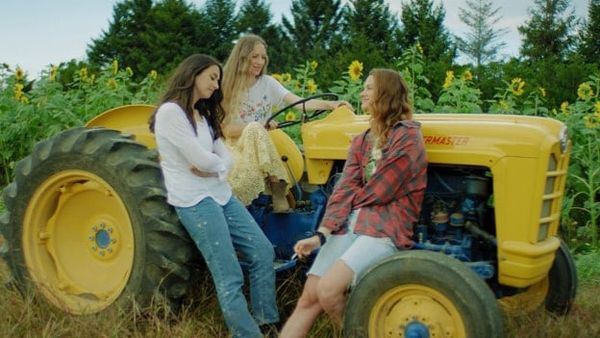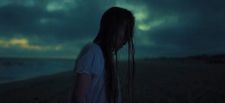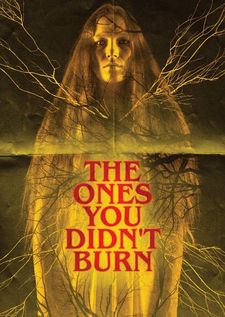 |
| Jenna Rose Sander, Estelle Girard Parks and Elise Finnerty in The Ones You Didn't Burn |
A slow-burning, sensual story whose rich visual and auditory landscape imprints itself on the brain as it explores issues around family, legacy and people’s relationships to land, The Ones You Didn’t Burn was one of the more memorable offerings from the festival circuit over the past year. It marked the arrival of a new talent in Elise Finnerty, who had made shorts before but struck out in a bold new direction with this. She also stars in it, as Alice, one of a pair of farmhands (alongside her filmmaking partner Estelle Girard Parks) who may also be witches, and whose presence complicates the relationship between struggling addict Nathan (Nathan Wallace) and his estranged sister Mirra (Jenna Rose Sander) as they return to the area to decide what to do with land they have inherited from their father. With the film about to be released on both sides of the Atlantic, Elise and I got in touch and she told me how the project began.
“It was over the pandemic, it was spring of 2020, and all production was shut down. Estelle and I started our company five or six years ago and we were in a tough spot. We wanted to make something. There were so many other talented artists, actors and photographers and things like that, that were just sitting around, and we got this special loan from the government, a Covid relief loan. And instead of making a short, I was like, ‘We should just go ahead and make this feature.’
“I was living at home at my parents at the time. I moved out of the city, not willingly, but like a lot of people. And one of my best friends, he's a 12th generation farmer, and he volunteered his farmland. He was like, ‘If you want to shoot something here, go ahead.’ So I was thrilled, and that was pretty much the first seed that made me want to tell a story using his land.
 |
| "I view the film as like a love story to the place that I grew up" - EF |
“I'm such a feminist and I have such powerful, beautiful women in my life. I had actually just come from this little road trip with two of my girlfriends. We went into the desert and we did this camping session, and we brought tarot cards. It felt very ceremonial, you know? Very uplifting and empowering. And for some reason, at that time in my life, it was what gave me strength and comfort and helped the creative juices flow, writing-wise.”
It’s a stunning location.
“Yeah. It was in a good place, in my hometown. I spent so much time there and in a way I view the film as like a love story to the place that I grew up – not just the farmland but the ocean. Those shots of Nathan sitting and just looking out into the sea is something that I've done, and I found a lot of comfort there, so I think it's probably my nostalgic lens coming through and making everyone feel like they're really at home because I felt at home, but obviously in the plot the characters do have such a tie to the land, all of them, not just the farm hands or, you know, witches, as we can call them, but also Nathan and his sister who are tied through their generational trauma and trying to work out what to do with it. That's something that's very real to my area, farmers getting this land passed down and deciding whether to sell it or keep it and, you know, family turmoil around that.”
There’s a long history in cinema of filming women in such locations and objectifying them as the mysterious other, but Elise seems to be doing something different; we immediately feel their power.
“Estelle’s character, Scarlett, was more of the sea,” she says. “She had this long hair and we dressed her in blues, and of course we see her in the sea. She was, for me at least, representing the women that were drowned. My character, who has red hair and is always wearing red – and of course, there’s that ending scene when we're flushed in that red colour – was more representing the women that were burned, symbolically. But in terms of how we fit into the land, I think it's metaphorical in a sense, because it was taken from us, but also we're still there. It's like we're ghosts of the land in a way, and we never really left.”
Mirra’s style doesn’t fit with the land to begin with, she observes, but over time, under the influence of Scarlett and Alice, she begins to present herself in a different way.
 |
| "Nathan's character is lost, he doesn't really have a home and he doesn't have any grounding" - EF |
It must have been tough, I venture, to shoot those scenes in the sea.
“Oh yeah!” She laughs. “Yeah, we shot in September and early October. Luckily, the ocean warms up. It's actually much colder now and in July, but it warms up and it takes a while to cool down. But she was freezing. We did it really quick. We didn't put her directly in the water, we just got her all wet, and then she did her thing and then we wrapped her in a blanket. But yeah, not only the ocean. Nathan we put in our pool, because he's drowning, which is supposed to be in the ocean, in our pool, and that was really cold too. But they were troopers. Everyone in that crew and cast is such a trooper, and was down to do anything that it took.”
There’s also incredible light in that landscape. How much of it was natural?
“It was mostly natural light, actually. And that was deliberate, not only from a creative perspective, but mostly from time restriction. When I was talking to Brett [Phillips], our cinematographer, early on, we had to film this in such a short amount of time that we made the choice to have a lot of the scenes outdoors, not only because of Covid air circulation, but so we didn't have to spend a lot of time setting up lights and we could move through the scenes with more speed. It's interesting because a lot of it seems that maybe if I hadn't written it with that in mind it would have been at night or would have been indoors, but we really took advantage of the sun and we had nine days of sunshine.”
I tell her that I think all that sunshine makes it stand out, at least amongst horror films.
“It's true, it's true. Yeah, you know, I was watching Midsommar, Ari Aster's film, and that was definitely inspiring to me because it's the same thing. I haven't seen a lot of horror movies that are so bright. It’s a good creative choice.”
I was also really impressed by the subtle body language between the actors playing the siblings, and how much it adds to the story, especially when Nathan and Mirra are thinking about their father but trying to avoid actually having to talk about him.
 |
| "Estelle’s character, Scarlett, was more of the sea" - EF |
“I really credit my actors with that,” she says. “They're friends of mine and we've all worked together, we've all acted together in other types of scenes in Peter Jensen's class at Terry Schreiber Studio in New York. And so I think there was just a natural chemistry that we all had, and a trust, and once they read the script, I think they both immediately got it. But we really talked a lot about the backstory between them and what their relationship with their father was, and also what their relationship with their mother was. I think they captured this estranged sibling feeling where they love each other and they care about each other but they're also strangers in a way, and they're connected by blood, but there's so much layering, Mirra having to take care of her older brother and Nathan failing in that role as a protector.
“Nathan does such a good job of saddling this antihero, you know, we're rooting for him. And yet he's also the villain. You do care about him and you know he loves his sister, but he's got that tendency that his father had, that violence in him. He's trying to suppress it the whole time but then it comes out. It's a sign that sometimes we are just victims of our upbringing, whether or not we can fight it, you know?”
Nathan also seems a bit lost in that it’s such a female dominated film, and the women are so sure of themselves, he doesn’t seem to have much purpose. Might that be why the film hasn’t gone down as well with some male critics?
She laughs. “I was wondering that too. And it's funny, because the first few days, we filmed a lot of things before the relapse scenes, and he was so sweet. He had this beaten dog energy where he just was hurt and in pain. And I was asking, at this time, ‘Is he too nice? Is he too sweet? We can't love him.’ So I was a little worried about the audience thinking of the women as being the villains. I didn't want that just to be very black and white. I think what I wanted was, you can have empathy for both sides, really. I've had a lot of male critics love Nathan's character, and I love what he was able to do, and make everyone sympathise with him. But ultimately, it’s bigger than him.
 |
| "I was focusing on the history of the witches...and what is still being taken from women, as we can see in America right now" - EF |
“I think one of the first lines in the script that Nathan and I talked about was when he's sitting on the beach looking out. It says ‘Nathan's sad, searching eyes.’ His character is lost, he doesn't really have a home and he doesn't have any grounding, he doesn't really have any family. So it is tragic in that way too, because he comes back maybe looking for that, and he finds the opposite.”
I note that there are a number of horror films these days which are tackling America’s founding myths and problematising cherished beliefs about who land belongs to. She acknowledges this but says that the focus of her film was a little different.
“I was focusing on the history of the witches, which is American history as well, and what was taken from them, and what is still being taken from women, as we can see in America right now. I mean, that is crazy. Our film premièred at Chattanooga, our world première, and the day after, Roe versus Wade got overturned. It was the highest of the highs and the lowest of the lows. I obviously didn't predict that happening. No one did. But I think stories have their own soul in a way, and as much as I'd love to take credit for everything that came through this film, I do think that it took on its own shape, in a way. And I'm glad that it has the effect that it's having, and it's starting the discussions that it's starting, especially around women, but for American land in general, and how that represents, yeah, people have always had things taken from them in this country.”
Before we finish, I feel compelled to ask her about Daniel Reguera’s score, because along with the cinematography it really helps to elevate the film. She tells me that she was pleased by what I said about it in my review of the film.
“Dan’s score is a huge part of this film for me. And in fact, in the writing process, I was listening to, not this particular score, but other music he had written. It was such an inspiration for the vibe of the film and the energy that we had. Sometimes I'd be listening to his music late at night, writing a scene, and then I'd wake up in the morning and think ‘This is nuts!’” She laughs. “And once he read the script, he started writing his own music for it. He had a lot of themes, of course, that use the banjolin. That’s that string that you hear throughout. And he had church bells subtly placed in there for the religious aspect. He's a genius. We're in pre-production for our next film and he's on board for that. He's one of the first crew members we assigned because I knew that that was something I needed early on in the process.”
 |
| The Ones You Didn't Burn poster |
Can she offer any hints about what the next film is going to be?
“Yeah, it's called It Comes Back. It's another psychological film, more horror for this time, I would say, and it's about suppressed trauma and what happens when we don't face it. How it comes back.”
The success of The Ones You Didn’t Burn has added a bit of pressure to the next project, she admits, as she doesn’t want to disappoint anyone. She’s excited by how well this one has done on the festival circuit but she didn’t make it with big expectations in mind.
“To me, this film was more of a proof of concept for me as a director, to make the next one that we're working on now. And to see what we can make, you know? I was like, if we make a film, amazing. If it gets into one festival, unbelievable. If we sell, I’m passing out.”
She has just made a deal with Shudder.
“Yeah, so it will be on Shudder, streaming. And Julian, our agent from Jinga Films, he sold it to a few other territories overseas. And hopefully it will continue to find homes around the world on different platforms. That's the beauty of movies, is that you capture a time and then continues on for forever.
“With this film, we were having so much fun, because we didn't know what we could do. And here we are, three years later. It's kind of crazy but it's such a gift. It's a gift to make a movie at all, and it's an even greater gift to have such a wonderful experience. And then to have all the positive reviews around it. It's just, yeah, it's a dream.”





















